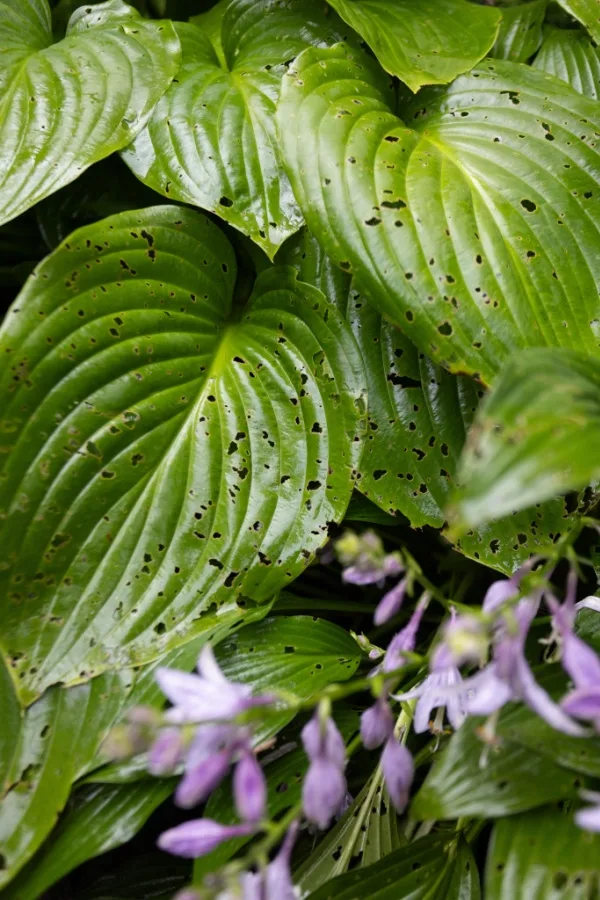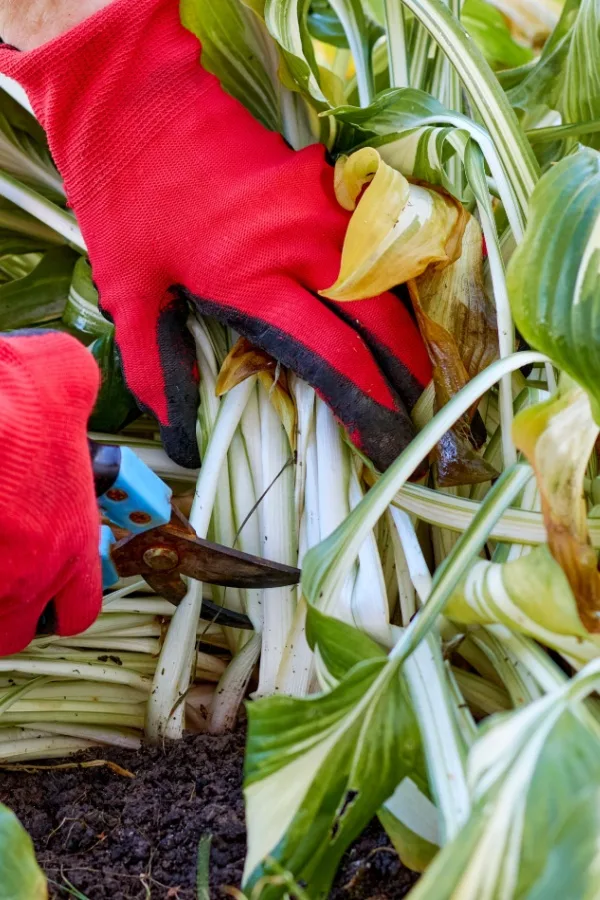Wondering what to do with your hostas after they bloom in the summer to keep them healthy, strong and beautiful until late fall?
Hostas are one of the most popular plants of all for gardeners looking to fill the shadier portions of their landscape with plants. One of the first perennials to push their foliage up in the spring, hostas add big interest with their large foliage – and even more when they bloom in mid summer.
But all too often, once hostas bloom, they seem to quickly begin to lose their luster. The leaves of the plant can start to look tattered and faded – and as the blooms fade off, the remaining bloom stem can be quite unattractive. Even worse, pests often begin to take their toll on them too.

But here’s the good news – by simply giving your plants a little TLC as they finish blooming, it’s more than easy to revive your hostas and keep them looking beautiful all throughout summer and long into fall. The key is to jump into action as the blooms fade!
Why Most Hostas Struggle Mid-Summer
So why are hostas so quick to lose their luster once mid summer arrives? For one, hungry deer and insects can cause quite a bit of damage to the leaves and foliage. Slugs, aphids, beetles, and a whole slew of other pests target hostas. See our article, “How To Keep Insects Off Your Hostas This Year”
But interesting enough, pests usually aren’t the main culprit of having hostas start to deteriorate by mid-summer. Most of the time, hostas simply run out of energy and power to keep their beautiful foliage lush and full. And this is especially true after blooming.

The energy hostas lose during their blooming period leaves plants weak. It also makes them far more susceptible to disease and pests. Without a little help, hostas can quickly fizzle out long before the heat of summer subsides. But that is exactly where a little summer care can make all the difference!
What To Do With Hostas After They Bloom
#1 Remove The Bloom Stem!
Around early to mid-summer, hostas push out long thin wispy stems that shoot up above the plant’s foliage. Each stem produces multiple blooms at the top, typically in light shades of white, lavender, blue, or pink.
While that might sound like a beautiful addition to their lush canopy of foliage, hosta blooms aren’t overly showy. In fact, many people think the spindly blooms take away from the beauty of the plant’s foliage. Because of this, they prefer to remove them as soon as they start to appear.
There are many benefits of removing the bloom stem early. The main being that the plant wastes a lot of energy and nutrients producing these lackluster blooms – nutrients that could be used instead to power the foliage and keep it strong and healthy.

If your goal in growing hostas is maintaining their beautiful foliage and keeping them looking beautiful all through summer and into fall, then it really is best to remove the bloom spikes as soon as they start to push up through the foliage. It is by far the best way to conserve plant energy.
Pruning After Hostas Bloom
For those that love the blooms of hostas, the next best course of action to help them is to deadhead them as soon as they finish blooming. And the faster you act, the better.
Even though a bloom might be dying, the plant will continue to waste precious energy attempting to “fix” the fading flower. By saving this energy, it then goes to helping the plant’s foliage instead.
When removing the bloom, don’t remove just the top of the flower. Cut the entire stem back all the way to the base of the plant. Leaving behind the stem will also still use precious resources from the plant.
Use a pair of clean, sharp pruners to cut the stem back as far down as possible. Repeat until you remove all of the stems. Product Link: Fiskars Bypass Pruning Shears 5/8” Garden Clippers
Proper Fertilization – What To Do With Hostas After They Bloom
Another important key to keep hostas healthy after they bloom is to feed them. Even though hostas are not heavy feeders like some flowering annuals and perennials, they still benefit greatly from a little boost of nutrients. Especially after blooming!

As with any plant, it takes quite a bit of energy and resources in order to push out blooms. This is especially true for perennials that are grown in the same soil year after year. If those nutrients aren’t replaced, the plants start to suffer.
It’s best to fertilize your hostas as soon as its blooms start to fade. If you removed the blooms prior, mid summer is still ideal for adding fertilizer. But what you add matters!
For hostas, an all purpose fertilizer with equal ratios of nitrogen, phosphorous and potassium is ideal. They use the nitrogen for stem and leaf growth – and the additional two nutrients to power overall plant health. Affiliate Product Link: Dr. Earth 91164 1 lb. 5-5-5 MINIS Life All Purpose Fertilizer
You can use either granular or liquid all-purpose fertilizers to provide plants with a quick supply of energy and nutrients. These products will help the foliage recover and stay strong. Look for a fertilizer in the 5-5-5 range for N-P-K.
Additional Care – What To Do With Hostas After They Bloom
Whether it’s out of control pest damage or harsh summer weather and conditions, even the best care might still leave you with ravaged and browning leaves. At this point, the foliage might be too far gone to salvage. But not all is lost!

With hostas, you can simply cut all of the foliage back to the ground and create a sort of “reset.” There is no need for worry. Hostas are hardy plants and will not die from this severe treatment.
Within just a couple of weeks, new growth will start to emerge from the base of the plant. Before you know it, your hosta plant will be back to looking healthy, lush, and full of life!
Here’s to keeping your hosta plants healthy and their foliage looking beautiful long after they bloom this summer!
Simple Garden Life
Follow Our Facebook Page For Even More Great Tips! Simple Garden Life Facebook Page
Simple Garden Life is a website dedicated to keeping gardening fun, simple and enjoyable! We publish two new articles each week along with a new garden podcast episode every two weeks. This article may contain affiliate links.
